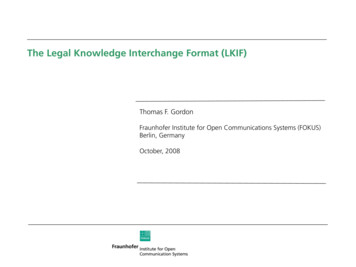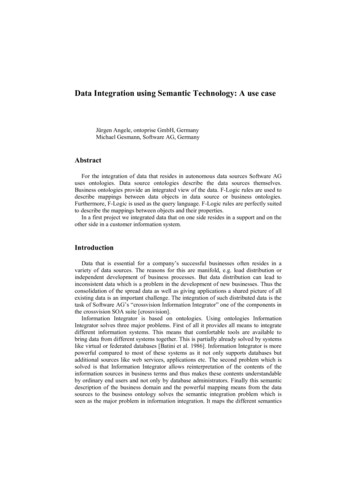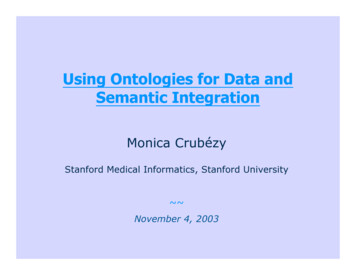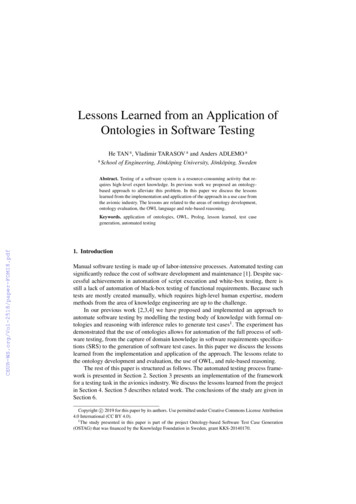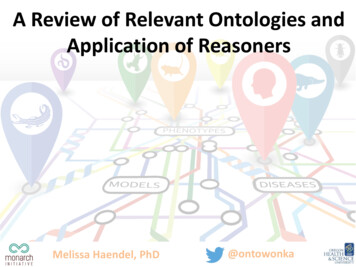
Transcription
Complex Systems Informatics and Modeling QuarterlyCSIMQ, Issue 1, March, 2014, (Pages 1-23)Published online by RTU Press, 7250/csimq.2014-1.01ISSN: 2255-9922 onlineUsing Ontologies for Enterprise Architecture Integration andAnalysisGonçalo Antunes1, Marzieh Bakhshandeh1, Rudolf Mayer2,José Borbinha1,3, Artur Caetano1,31INESC-ID, Information Systems Group, Rua Alves Redol 9, 1000-029 Lisbon, Portugal2SBA Research GmbH, Favoritenstraße 16, 1040 Wien, Austria3Higher Technical Institute, University of Lisbon, Av. Rovisco Pais 1, 1049-001 Lisbon, Portugalgoncalo.antunes@ist.utl.pt, marzieh.bakhshandeh@ist.utl.pt, rmayer@sba-research.at,jose.borbinha@ist.utl.pt, artur.caetano@ist.utl.ptAbstract. Enterprise architecture facilitates the alignment between differentdomains, such as business, applications and information technology. Thesedomains must be described with description languages that best address theconcerns of its stakeholders. However, current model-based enterprisearchitecture techniques are unable to integrate multiple descriptions languageseither due to the lack of suitable extension mechanisms or because they lack themeans to maintain the coherence, consistency and traceability between therepresentations of the multiple domains of the enterprise. On the other hand,enterprise architecture models are often designed and used for communicationand not for automated analysis of its contents. Model analysis is a valuable toolfor assessing the qualities of a model, such as conformance and completeness,and also for supporting decision making. This paper addresses these two issuesfound in model-based enterprise architecture: (1) the integration of domaindescription languages, and (2) the automated analysis of models. This proposaluses ontology engineering techniques to specify and integrate the differentdomains and reasoning and querying as a means to analyse the models. Theutility of the proposal is shown through an evaluation scenario that involve theanalysis of an enterprise architecture model that spans multiple domains.Keywords: Enterprise architecture, ontology, domain integration, ArchiMate,OWL.1 IntroductionEnterprise architecture is defined by Lankhorst as "a coherent whole of principles, methods, andmodels that are used in the design and realization of an enterprise's organizational structure,business processes, information systems, and infrastructure", with a "focus on alleviating theinfamous business-information technology alignment problem" [1]. Such alignment is typicallyachieved through the creation of models describing an enterprise, including business and ITelements, so that it can realize management requirements and be maintained over the period ofits useful life [2].Several enterprise architecture frameworks were developed through the years, providingmethods and techniques, including enterprise architecture modelling languages, as can bewitnessed, for instance, in [3]. However, and despite the efforts for developing comprehensiveapproaches to enterprise architecture, such as TOGAF [4] or ArchiMate [5], it can be noticed
that such "one language fits all" approaches are not enough for addressing the specifics of eachorganization, which can be attested by the emergence of situational approaches [6], [7], [8], [9].The use of situational approaches makes possible the combination of different method and modelfragments to suit the specificities of each scenario being addressed, which can be a means tomore effectively address the concerns of the stakeholders.Managing the dependencies between and within the different models created is crucial forsupporting the communication between the different stakeholders, and for ensuring theiralignment and consistency [10], [11]. However, the integration of multiple meta-models bringschallenges at the level of coherence and model consistency [12], [13], [14]. In terms oftraceability, it becomes difficult to maintain links among elements from the different models,which is a problem that gets exacerbated as the models evolve. Consequently, model consistencyis also hindered, namely when the models are created using different tools.Moreover, commonly used model representations (i.e., the way the information contained inthe models is structured and organized) create challenges to the analysis and evaluation of thealignment between business goals and the IT capabilities. On the one hand, the high complexityand detail of the information contained in the models makes the analysis exclusively by humanmeans hard. On the other hand, used model representations are typically inadequate forautomatic processing of the information contents of the models, with most of the tool supportavailable for that end providing limited analysis capabilities [15].As a result, there is a need for an extensible approach to enterprise architecture that ensuresmeta-model level coherence, which concerns encoding rules on the meta-model, and supportsmodel and cross-model verification, which concerns the evaluation of the conformance of themodels to the rules specified in the respective meta-models. Moreover, enterprise architecturemodels should be computable so that the effort involved in their analysis is manageable.Therefore, the following research questions can be raised: Research Question 1 - Model representation: How to represent the models in a way thatallows their integration? Research Question 2 - Model analysis: How to represent the models in a way that supportsthe production of relevant analysis for the different stakeholders? Research Question 3 - Analysis techniques: What information processing techniquesshould be used for determining the alignment of the information systems with the businessgoals?In order to be able to provide answers to the aforementioned research questions, we assumethat the following principles should be respected: Principle 1 - Flexibility: Support for covering the multiple viewpoints of stakeholdersshould be provided, including the capability for enriching the already existing information. Principle 2 - Computable models: A computable representation for the enterprisearchitecture models should be adopted. Principle 3 - Support for analysis techniques: Support for techniques allowing thedetection and analysis of alignment between system capabilities and business objectivesshould be provided.This paper raises the hypothesis that ontologies can contribute for solving the describedproblem. Ontologies describe a domain model by associating meaning to its terms and relations.A more formal and widely used definition is that of Gruber who defines an ontology as a "formalspecification of a conceptualisation" [16]. Several authors recognize ontologies and associatedtechniques as being valuable tools in the enterprise architecture domain [17][18][19][20][21].Enterprise architecture can benefit from the available knowledge and techniques, which canimprove model creation, extension and validation, through an explicit semantic definition of theconcepts present in different meta-models [22].The main contribution of this article is thus proposing an architecture based on the use ofontologies that provides the following features:2
Representation of enterprise architecture models, providing information processingcapabilities, namely computational inference and information querying, allowing for:oEnforcement of meta-model coherence, through the addition of axioms to theontologies enforcing semantic rules implicitly defined in the model specifications.oMeta-model conformance verification of models, since models specified accordingto a determined meta-model can be verified against the semantic rules specified inthe ontology through the use of reasoners, allowing for the verification of logicalinconsistencies present in models.oInformation processing mechanisms that can be used to support decision-making,through the usage of computational inference and querying mechanisms, allowingfor better information retrieval and processing. Ontological integration of the viewpoints of different stakeholders, offering improvedextensibility and expressiveness of the Enterprise Architecture, through the management ofthe inclusion of new domain-specific meta-models in a standard way, with the aimcapturing specific aspects of organisations.We demonstrate the applicability of the proposal through the application of formal ontologiesto model a set of different enterprise architecture domains and through the consistent integrationof these domains. In particular, we develop an ontology to specify the ArchiMate 2.0 metamodel and then create traceable maps to it from a set of domain-specific languages. We alsodescribe an example that maps the sensor technology domain to ArchiMate in the context of areal-world scenario. This demonstration shows that the application of ontologies to EnterpriseArchitecture modelling effectively assists consistently aligning and analysing different domains.This work is organized as follows. In section 2, related work is described. In section 3, someof the current issues existing in Enterprise Architecture practice which this work intends toapproach are discussed. Section 4 presents a proposal based on ontology techniques forimproving the representation of architecture models. Section 5 presents a proposal based onontology techniques for improving the analysis of architecture models. Section 6 describes animplementation of the proposal. Section 7 evaluates the proposal through its application to aconcrete scenario. Finally, Section 8 concludes the paper and provides directions for future work.2 Related Work2.1 Enterprise Architecture Model IntegrationWhen integrating the architectural data specified in different models two approaches arepossible: a holistic approach or a federated approach [23]. In the holistic approach, a singlemodel comprising all the needed artefacts is used, which means that any information specifiedusing a different meta-model as a basis has to be converted into it, in order to be integrated. Onthe other hand, a federated approach based on meta-model integration uses specialized modelsthat are linked to a main model.Different works dealing with federated model integration in enterprise architecture have beenpublished through the years. One of the earliest mentions to model integration in this specificdomain was the Enterprise Model Integration (EMI) [24] approach. EMI is based on "objectoriented meta-modelling" concepts to describe specific languages, which can then be integratedvertically (i.e., top-down or bottom-up), horizontally, or using an hybrid approach. Differenttypes of patterns are then specified for describing the types of mappings between two metamodels, addressing the cases where the meta-models complement each other or when they areused concurrently. In the first case, reference links or transformation rules can be used, whereasin the second case merge rules are used.In [25], the ArchiMate language is first proposed as a way to "bridge between other existingmodelling languages", which provides an high-level set of concepts that can be specialized using3
specific models. In order to support this proposal, a workbench for the integration of modellinglanguages and tools is presented. The integration is achieved through the use of bi-directionaltransformational rules that can be used to detail ArchiMate model elements into more detailedmodels, specified in a more specific language. The proposal made in this work and itsimplementation is greatly influenced by this work. Follow-up works include [26], whichapproaches the integration of functional with non-functional models and design with analysismodels, and [27], which deepens the integration role of ArchiMate by discussing its integrationwith symbolic, semantic and subjective models.The work in [28] extends the EMI approach with mappings and rules for meta-modelintegration, providing a catalogue of rules that can be instanced in specific integration scenarios,thus making EMI situational. The work in [29] advocates the use of a federated approach tobusiness architecture engineering that integrates generic meta-modelling methods with businessarchitecture meta-models. For that it proposes a method based on the identification of thestakeholder concerns and specification of meta-models for addressing them, and integrating thedifferent meta-model fragments resulting from the exercise. The integration is done through thecreation of mappings reflecting similarity, generalisation or specialisation.More recently, an approach based on the use of meta-model fragments extending a core metamodel, focusing in different qualities is described in [6]. The work in [30] maps concepts from arisk management domain model into ArchiMate using generalisation and specialisationrelationships between the concepts of the two meta-models. In [31], the Enterprise ServicesArchitecture Meta-model Integration (ESAMI) is described as being a "correlation-basedintegration method for architecture viewpoints, views, and models", for integrating serviceoriented enterprise architectures.2.2 OntologiesThe term ontology comes from the Greek ontos (being) logos (word), literally meaningexistence [32]. From the perspective of philosophy, ontology is the systematic explanation ofbeing [32]. In computer science, the most widely used definition characterizes ontologies as"formal, explicit specification of a shared conceptualization" [16]. In this definition,"conceptualization" refers to an abstract model of phenomena in the world by having identifiedthe relevant concepts of those phenomena, "explicit" means that the type of concepts used andthe constraints on their use are explicitly defined, "formal" refers to the fact that the ontologyshould be machine readable, and "shared" reflects that the ontology should capture consensualknowledge accepted by the communities [34].Uschold divides the uses of ontology into three categories [35]: human communication,interoperability, and systems engineering. In human communication, ontologies reduceconceptual and terminological confusion and enable shared understandings between people withdifferent needs and viewpoints. When used for interoperability ends, it improves the exchange ofdata among heterogeneous sources. When engineering systems, a shared understanding ofproblems can also assist in the systems' specification. Informal (simple) ontologies can be thebasis for manual checking of designs against specifications, to improve systems reliability.Ontologies can also foster reusability, enabling the reuse of knowledge models in newapplications. In this case, ontologies are used to make the underlying assumptions of softwarecomponent design explicit [32], [35]. Guarino has also provided a listing of the fields making useof ontologies, which includes: knowledge engineering, knowledge representation, qualitativemodelling, language engineering, database design, information retrieval and extraction, andknowledge management and organization [36].According to Uschold [35], there are several formalization degrees in ontology, whose rangeextends from the most informal to the more formal including: Informal (natural language)4
Semi- informal (restricted and structured form of natural language)Semi-formal (languages such as Ontolingua, UML, OWL)Rigorously formal (meticulously defined terms, formal semantics and theorems, soundnessand completeness proofs )The spectrum of ontology formalization in computer science [32] is depicted in Figure 1.According to this figure, there are two main groups of ontologies: non-structured or simple (i.e.,left of the spectrum) ontologies, and structured ontologies (i.e., right of the spectrum). Thedegree of structure of the ontology depends on the purpose of use of ontology. The simplest formof ontology is a catalogue which is a controlled vocabulary (i.e., a finite list of terms). Anotherpotential ontology specification is a glossary (i.e., a list of terms and meanings). The conceptsand meanings in these types of ontologies are typically specified in natural language statements.This provides a kind of meaning description for human consumption since humans can read thenatural language statements and interpret them.Figure 1. Ontology Spectrum [37]However, interpretations of this type of specification are not unambiguous and thus they arenot adequate for computer agents, not meeting the criteria of being processed by machines.Thesauri provide some additional semantics concerning the relations between terms, for instance,synonym relationships. In many cases, the relationships defined therein may be interpretedunambiguously by agents. Typically, thesauri do not provide an explicit hierarchy.An inclusion of strict sub-class hierarchies (i.e., is-a relationships between concepts) improvesdeduction possibilities over ontologies. Another step further in terms of ontology formalizationincludes using frames. Frames are a knowledge representation scheme very similar to classdiagrams. When using frames, concepts are represented through classes. Each class has a set ofproperties, with each property having a type, a set of values and value restrictions.Description logics (DL) are a family of logic based knowledge representation formalisms usedto describe domains in terms of concepts, roles and individuals, including their relationships. DLallows the definition of axioms that are logical statements about the "relationships betweenproperties and/or classes in the domain" [38]. In that sense, DL are a step further in ontologyformalization as they allow the expression of logic constraints that are not possible outside thespecification of a frame.2.2.1 Ontology IntegrationThe word integration has been used with different meanings in the ontology field. In simpleterms, ontology integration is the process of identifying common concepts and relationshipsshared between two or more ontologies [39]. Three main techniques of ontology integration canbe described as follows. Ontology alignment: is the process of building a new ontology by identifyingcorrespondences between all the concepts of two ontologies, which are said to beequivalent. Ontology mapping: is the process of building a new ontology by finding common conceptsbetween two (or more) concepts belonging to two (or more) different ontologies.5
Ontology merging: is the process of building a new ontology by merging severalontologies into a single one that will “unify” all of them, and create a more generalontology about a subject.One of the big challenges in ontology mapping is finding the semantic mappings between twogiven ontologies. Figure 2 shows a high-level view of the mapping process [40], [41]. Anessential element when performing the mapping is the matcher. The matcher tries to discovercorrespondences between different ontology entities from narrow perspectives [42]. It buildscorrespondences between different ontologies by first selecting an appropriate feature (e.g.,entity label, structural description of concepts, and range for relations, instantiated attributes orextensional descriptions) from the ontologies [40].Figure 2. A simplified high-level view of a mapping processCommon mapping approaches link candidate ontologies to a common ontology using anchors[43], [40], [42]. Anchors are entities which are declared to be equivalent. Finally, matchersevaluate the similarity criteria of both ontologies. Frequently, functions based on heuristicsimilarity instead of exact logical similarity are used to avoid a costly complete search. Iteratingstops when there are no more new mapping proposals [44].Different types of mismatches may occur between different ontologies [40], [45], [46], [47]: Syntactic mismatches: Two ontologies are syntactically heterogeneous if they arerepresented by different representation languages. To resolve this type of mismatches,simply transform the representation language of one ontology to the representationlanguage of the other ontology. However, many times translation is difficult and evenimpossible and may lead to source information omission. Lexical mismatches: Describes the heterogeneity between the names of entities, instances,properties or relations. They are four forms of heterogeneity:oSynonyms: The same entity is represented by two different names.oHomonyms: The same name represents two different entities.oThe same name in different languages labelling the same entity.oThe same entities are named with the same words but with different syntacticvariations, such as abbreviations, optional prefixes or suffixes Semantic mismatches: The mismatches identified at this level are related to the content ofthe input ontologies. This is the most challenging mismatch. Three abstract forms ofmismatches can be described:oCoverage: Two ontologies are different from each other in that they cover different(possibly overlapping) portions of the world (or even of a single domain).oGranularity: Two ontologies are different from each other in that one provides amore respectively less detailed description of the same entity.oPerspective: Two ontologies are different from each other in that one may provide aviewpoint on some domain which is different from the viewpoint adopted in anotherontology.6
2.2.2 Ontology ReasoningOne of the key features of ontologies is that they can be validated and analysed by reasoningmethods. The term reasoning is used, in the context of ontologies, to denote any mechanism formaking explicit a set of facts that are previously implicit in an ontology. The two main purposesof reasoning are validation and analysis [48].Validating an ontology means ensuring that the ontology is a good representation of thedomain of discourse that you aim at modelling. Reasoning is extremely important for validation.For example, consistency checking is a kind of reasoning, which can be performed to capturepossible inconsistencies in the definition of the classes and properties of the ontology. Also, areasoner can then be used to obtain inferred information about the model, such as inferred superclasses, inferred equivalent classes, and inferred types for individuals.In analysis one assumes that the ontology is a faithful representation of the domain, and triesto deduce facts about the domain by reasoning over the ontology. Moreover, it tries to collectnew information about the domain by exploiting the ontology. Clearly, analysis can also provideinput to the validation phase.In the recent years logical reasoning has been widely used in the field of ontology engineering.There are some forms of logical reasoning, including reasoning in classical logic and nonclassical logic [48], [49], [50]. Reasoning in classical logic is related to the idea of provingtheorems in classical first order logic. This can be characterized as the task of checking whethera certain fact is true in every models of a first-order theory. A well-known example of reasoningthat cannot be captured by classical logic is the so-called defeasible reasoning. Although we canstate in an ontology that all birds fly, it is known that penguins are birds that do not fly. This is aform of non-monotonic reasoning: new facts may invalidate old conclusions. Since classicallogic is monotone, this goes beyond the expressive power of classical logics.3 Problem: the Need for Flexible and Computable Enterprise ArchitectureIn this section, we describe and analyse the problem addressed by this work. In order to groundour proposal in good practice, the architecture principles that a solution for the problem shouldabide for are defined. An architecture principle can be described as "a declarative statement thatnormatively prescribes a property of the design of an artefact, which is necessary to ensure thatan artefact meets its essential requirements" [51].According to the ISO/IEC/IEEE 42010 [52], a system architecture description includes viewsthat address the concerns of the system stakeholders. Those views are created according to theviewpoints of the stakeholders. Correspondence rules are created between the views to enforcecomposition, refinement, consistency, traceability, dependency, constraint and obligationrelationships between the views [52]. In this way, architecture can function as a communicationtool between different stakeholders, as each is presented with its own consistent view on thesystem of interest, displayed in a manner that is understood by him. Architecture Principle 1 - Concern orientation: The architecture of the solution shallrepresent the concepts necessary and sufficient to address an explicit set of modellingconcerns. This means that the model shall be derived from the questions that need to beaddressed and to provide answers to those questions. This also means that the model shallnot support any concepts that are not explicitly derived from stakeholder concerns. Architecture Principle 2 - Expressiveness: The architecture of the solution shall be able torepresent the domain concepts without ambiguity in order to improve communication. Thisentails defining the minimum set of types and relationships to describe a domainAlthough the need for multiple views on the system is recognized by the standard, the truth isthat it is a challenge to maintain these relationships when multiple independent meta-models andmodels are involved [25]. As such, some enterprise architecture modelling approaches try to be7
as comprehensive as possible up to a certain level of abstraction, providing a meta-model thatapproaches the different layers of an organization [23]. But the fact is that, many times, theintegration of many meta-models is imperative in order to provide project or domain-specificsolutions to many problems [23][28]. Architecture Principle 3 - Extensibility: The architecture of the solution must cope withextensions because context modelling entails using multiple concurrent perspectives on thesame problem. This derives from being able to answer to multiple concerns. Therefore,domain-specific and domain-independent models must coexist and the overall architecturemust cope with multiple model transformation and integration. A specific concern is thatthe architecture is extensible to new application domains.Using multiple meta-models often requires using multiple specialized tools, making itespecially problematic to ensure the consistency across models, especially when the metamodels evolve [53]. The automatic or semi-automatic validation of the conformance of themodels to the meta-models might be available or not, depending on whether the models are fullycomputable (abstract syntax and semantics) or not, or on the existing tool support. Architecture Principle 4 - Modularity: The architecture of the solution must follow theprinciples of high-cohesion and low-coupling. Observing these principles contributes toexpressiveness and extensibility of the architecture. It is especially important that addingnew domain-specific aspects to the model does not interfere with the concepts alreadypresent in the model.Enterprise Architecture should also provide support to governance and decision making [1],[54], functioning as an important information source for informed decisions. Given that thepurpose of models is to answer questions about the modelled entities [54], the ability to analysethe models for retrieving answers to the stakeholders is also desirable [55]. Stakeholders shouldbe able to obtain as much useful information as possible from the knowledge contained in themodels, which might reach a great level of complexity when elaborated with detail [56]. Suchanalysis can of course be made without any automation, however, it can be difficult obtain usefulinformation when dealing with complex scenarios [57].Given this, creating computable representations for enterprise architecture models comes outas a relevant need [58]. The combination of the computable models along with the enforcementof the dependencies brings benefits for enterprise architecture, such as retrieval, management,and processing of information. One example of such benefits is dependency analysis, which canbe used for evaluating the alignment between the business and IT concepts. Architecture Principle 5 - Viewpoint-orientation: The architecture of the solution mustsupport defining views over subsets of its concepts. This serves to facilitate thecommunication and the management of the models as viewpoints act as a separation ofconcerns mechanism. Viewpoints will facilitate addressing multiple concerns and canimprove decision-making by isolating certain aspects of the architecture in viewsaccording to the needs of decision makers. In that sense, viewpoint specifications can be assimple as a filter that is applied on the overall constellation of enterprise architecturemodels, or as complex as an algorithm that uses the information contained on the modelsfor performing a determined computation.Next section described a proposal for the representation of enterprise architecture models thataddresses the listed design principles.4 Proposal: Representation of Enterprise Architecture Models UsingOntologiesAddressing the need for a representation that allows integration of different meta-models andtheir analysis by computational needs, our proposal is based on the hypothesis that ontologies are8
able to represent, integrate and extend enterprise architecture models. Our approach is groundedin the following concepts: Upper Ontology (UO): a core meta-model, which represents a minimum set of enterprisearchitecture concepts and which can be considered domain-independent (i.e., that does notaddress any specific domain-dependent concerns and that can be applicable to the majorityof the scenarios), thus addressing the architecture principles 1 and 2 (cf. section 3). Domain-Specific Ontologies (DSOs): In order to address the arc
2 Related Work 2.1 Enterprise Architecture Model Integration When integrating the architectural data specified in different models two approaches are possible: a holistic approach or a federated approach [23]. In the holistic approach, a single model comprising all the needed artefacts is used, which means that any information specified .
